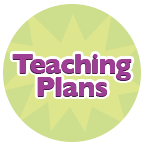Oral Language Teaching Strategy:
Promote Piggy-Backing Encourage the expansion of conversation through ‘piggy-backing’ (adding to another person’s ideas).
Time: 20–25 minutes
Materials:
– girl puppet
– lady puppet
– bear puppet
– small box to represent a cooler and a tiny container to represent a jar of honey
Grouping: whole class and partners
Assessment: Use selected items from the Kindergarten Oral Language Assessment Scale for recording your observations.
BEFORE MODELLING
-
Introduce the lesson’s focus of using puppets for retelling personal experiences. Explain to students that you are going to use puppets to retell something that happened to yourself. (Substitute an experience of your own for your demonstration lesson.)
Setting a Purpose
- Establish the purpose for listening and viewing. Ask students to listen to your story to find out what happened to you.
DURING MODELLING
-
Retell a personal experience using the puppets, acting out events when appropriate. The following is an example of a possible retelling:
| Lady Puppet: | Chantelle and I went camping in Jasper Park. (Girl puppet on one hand and lady puppet on the other.) |
| Girl Puppet: | We set up the tent trailer. (Add actions.) |
| Lady: | From our campsite we could see the snow-topped mountains and tall spruce trees. |
| Girl: | We chopped wood for our fire. (Add actions.) |
| Lady: | We toasted marshmallows on our fire. (Add actions.) |
| Girl: | We were so tired we went to bed early. (Both fall asleep.) |
| Lady: | In the middle of the night I heard a noise outside. I looked out of the window and saw a bear in the moonlight. The bear was knocking over things. (Replace girl puppet for bear puppet and show it crashing around in the campsite and chewing things. Bear rolls away the jar of honey.) |
| Lady: | I stayed very still and hoped the bear wouldn’t check out our trailer. (Shiver.) |
| Girl: | (Replace bear puppet for the girl puppet.) The next morning we looked over the campsite. Chairs had been tipped over and our cooler was by the trees. |
| Lady: | We realized we’d forgotten to put the cooler in the car, but really there was nothing in it except for a small jar of honey. |
| Girl: | We picked up the cooler and saw big tooth marks through one corner. We never found the jar of honey! (Add actions.) |
| Lady: | We still use the cooler. |
| Girl: | The teeth marks remind us to put the cooler away at night so we don’t meet any more bears in our campsite! |
AFTER MODELLING
- Revisit the purpose for listening and viewing. Ask students to tell a partner about what happened. Then ask how you retold the story. Offer prompts:
- Did I tell you everything that happened on our camping trip? Why not? Why do you think I picked that part?
- Who told the story?
- Had that really happened to them?
- I talked, but how did I show what happened too?
-
Devonne listened to Ryan when he said, “You couldn’t tell us everything that happened. You wouldn’t remember.” Devonne added, “The play would be too long as well.” It’s good to add to other people’s ideas.
As students talk, listen carefully to observe an occasion when one student added to another’s student’s ideas. Use the opportunity to identify and reinforce a positive conversational strategy.
-
Close your eyes and think of something you’ve done that you could retell with puppets. It could be about playing with a friend, going on a trip, having a birthday party, swimming, anything that you’ve done.
During centre time, ask students to think of an experience they could make into a puppet play.
-
If two or three of you have shared the experience, like going to a party, or playing a game, then you can retell it together.
Have students to talk with a partner about their experiences. Explain that students could tell about something that really happened to them when they played with puppets at centre time.
